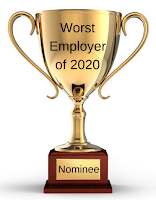The federal government recently released an updated Form I-9, and although employers aren’t required to use the new version until May 1, 2020, best practices dictate that they should start using it immediately. The Form I-9 verifies the identity of new hires and ensures they are authorized to work in the United States, and it is the first update from the United States Citizenship and Immigration Services in a few years.
With this recent announcement, employers should take immediate steps to ensure compliance with the new form — or risk financial penalties.
Minor, but important changes
There has only been a subtle change to the form itself. Specifically, USCIS revised the Country of Issuance field in Section 1 and the Issuing Authority field (when selecting a foreign passport) in Section 2 to add Eswatini and Macedonia, North, because those countries recently announced name changes.
 This change is visible only when completing the fillable Form I-9 on a computer. The paper version of the new I-9 will look identical to the current version dated July 17, 2017.
This change is visible only when completing the fillable Form I-9 on a computer. The paper version of the new I-9 will look identical to the current version dated July 17, 2017.
However, changes to the form’s instructions are more substantive:
- Updated website addresses and other contact information: The instructions no longer contain contact information for the Immigrant and Employee Rights Section of the Department of Justice.
- Clarification as to who can act as an authorized representative on behalf of an employer: The instructions make clear that employers can designate “any person” to complete and sign Section 2 of the I-9 on the employer’s behalf. The instructions also make clear that the employer, not the authorized representative, is liable for any violations committed in connection with the I-9. The lesson here is that while you may choose anyone to serve as an authorized representative, choose carefully and make sure they understand how to correctly fill out Section 2.
- Instruction that employers who enter information in Section 2, List A should not enter N/A in Lists B and C (and vice versa).
- Updates on the process for requesting paper Form I-9s (as an alternative to printing them from the USCIS website) and an updated Department of Homeland Security Privacy Notice.
Begin using new form immediately
Although employers can continue using the previous Form I-9 through April 30, 2020, it makes sense to scrap the use of the July 17, 2017 version and begin using the updated version right away. Employers should recycle all older blank versions they already have printed and instruct their hiring managers and human resources representatives to download the new Form I-9 for use with new hires going forward.
On May 1, 2020, all employers will be required to use the revised form, so they should avoid any delay and begin using the new version immediately. It’s important to remember, however, that they should not require current employees to fill out the new I-9 form. Rather, they should use the new Form I-9 only for new hires moving forward.
Also read: 3 ways HR leaders can stay ahead of changing immigration policies
Non-compliance can be costly
Although the changes to the Form I-9 and its instructions are slight, failure to use the new form and comply by the May 1 deadline can result in large fines. I-9 audits have increased threefold in recent years (from 1,360 to 5,981 per year), while worksite investigations have increased even more dramatically (from 1,691 to 6,848 per year).
Potential fines are also increasing — paperwork violation fines can now range between $230 to $2,292 per employee. Civil penalties for knowingly hiring or employing unauthorized workers currently range from $573 to $4,586 per employee for the first violation. Second- and third-violation civil penalties can range between $4,586 up to $22,972 per employee. Arrests and criminal convictions for knowingly hiring or employing unauthorized workers are on the rise as well.
Conclusion
It is unlikely that the Trump administration will slow down DHS’s employer-driven immigration compliance mechanisms. Based upon recent actions from the administration to increase enforcement and hire more ICE agents, along with statistics demonstrating significant increases in I-9 audits and worksite investigations, it is increasingly likely you could face enforcement actions in the form of ICE audits, workplace raids and employee detention. Accordingly, now is the time to review your I-9s and your compliance policies to minimize exposure should the government show up on your doorstep demanding to see your I-9s.
Also read: Do you know what to do if ICE shows up at your business?



 Every year I worry about how I’m going to fill my annual list of worst employers. I’ve yet to be disappointed.
Every year I worry about how I’m going to fill my annual list of worst employers. I’ve yet to be disappointed.








